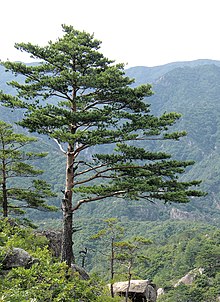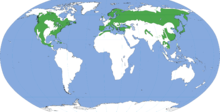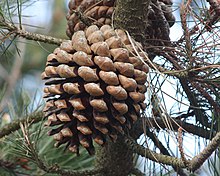
A | B | C | D | E | F | G | H | CH | I | J | K | L | M | N | O | P | Q | R | S | T | U | V | W | X | Y | Z | 0 | 1 | 2 | 3 | 4 | 5 | 6 | 7 | 8 | 9
| Pine Temporal range:
| |
|---|---|

| |
| Pinus densiflora (Korean red pine), North Korea | |
| Scientific classification | |
| Kingdom: | Plantae |
| Clade: | Tracheophytes |
| Clade: | Gymnospermae |
| Division: | Pinophyta |
| Class: | Pinopsida |
| Order: | Pinales |
| Family: | Pinaceae |
| Subfamily: | Pinoideae |
| Genus: | Pinus L. |
| Type species | |
| Pinus sylvestris | |
| Subgenera | |
|
See List of Pinus species for complete taxonomy to species level. See list of pines by region for list of species by geographic distribution. | |

| |
| Range of Pinus | |
| Synonyms | |
| |
A pine is any conifer tree or shrub in the genus Pinus (/ˈpaɪnəs/)[1] of the family Pinaceae. Pinus is the sole genus in the subfamily Pinoideae.
World Flora Online accepts 187 species names of pines as current, with additional synonyms, making it the largest family among the conifers.[2] The American Conifer Society (ACS) and the Royal Horticultural Society accept 121 species. Pines are widely distributed in the Northern Hemisphere; they occupy large areas of boreal forest, but are found in many habitats, including the Mediterranean Basin.
The timber from pine trees is called "pine"; it is one of the more extensively used types of timber. There are currently 818 named cultivars (or trinomials) recognized by the ACS.[3] It is a well-known type of Christmas tree.
Description
Pine trees are evergreen, coniferous resinous trees (or, rarely, shrubs) growing 3–80 metres (10–260 feet) tall, with the majority of species reaching 15–45 m (50–150 ft) tall.[4] The smallest are Siberian dwarf pine and Potosi pinyon, and the tallest is an 81.8 m (268 ft) tall ponderosa pine located in southern Oregon's Rogue River-Siskiyou National Forest.[4]

Pines are long lived and typically reach ages of 100–1,000 years, some even more. The longest-lived is the Great Basin bristlecone pine (P. longaeva). One individual of this species, dubbed "Methuselah", is one of the world's oldest living organisms at around 4,800 years old. This tree can be found in the White Mountains of California.[5] An older tree, now cut down, was dated at 4,900 years old.[6][7] It was discovered in a grove beneath Wheeler Peak and it is now known as "Prometheus" after the Greek immortal.[7]
The spiral growth of branches, needles, and cones scales are arranged in Fibonacci number ratios.[8][9] The new spring shoots are sometimes called "candles"; they are covered in brown or whitish bud scales and point upward at first, then later turn green and spread outward. These "candles" offer foresters a means to evaluate soil fertility and vigour of the trees.
Bark

The bark of most pines is thick and scaly, but some species have thin, flaky bark. The branches are produced in "pseudo whorls", actually a very tight spiral but appearing like a ring of branches arising from the same point. Many pines are uninodal, producing just one such whorl of branches each year, from buds at the tip of the year's new shoot, but others are multinodal, producing two or more whorls of branches per year.
Foliage
Pines have four types of leaf:
- Seed leaves (cotyledons) on seedlings are borne in a whorl of 4–24.
- Juvenile leaves, which follow immediately on seedlings and young plants, are 2–6 centimetres (3⁄4–2+1⁄4 inches) long, single, green or often blue-green, and arranged spirally on the shoot. These are produced for six months to five years, rarely longer.
- Scale leaves, similar to bud scales, are small, brown and not photosynthetic, and arranged spirally like the juvenile leaves.
- Needles, the adult leaves, are green (photosynthetic) and bundled in clusters called fascicles. The needles can number from one to seven per fascicle, but generally number from two to five. Each fascicle is produced from a small bud on a dwarf shoot in the axil of a scale leaf. These bud scales often remain on the fascicle as a basal sheath. The needles persist for 1.5–40 years, depending on species. If a shoot's growing tip is damaged (e.g. eaten by an animal), the needle fascicles just below the damage will generate a stem-producing bud, which can then replace the lost growth tip.
Cones

Pines are monoecious, having the male and female cones on the same tree.[10]: 205 The male cones are small, typically 1–5 cm long, and only present for a short period (usually in spring, though autumn in a few pines), falling as soon as they have shed their pollen. The female cones take 1.5–3 years (depending on species) to mature after pollination, with actual fertilization delayed one year. At maturity the female cones are 3–60 cm long. Each cone has numerous spirally arranged scales, with two seeds on each fertile scale; the scales at the base and tip of the cone are small and sterile, without seeds.
The seeds are mostly small and winged, and are anemophilous (wind-dispersed), but some are larger and have only a vestigial wing, and are bird-dispersed. Female cones are woody and sometimes armed to protect developing seeds from foragers. At maturity, the cones usually open to release the seeds. In some of the bird-dispersed species, for example whitebark pine,[11] the seeds are only released by the bird breaking the cones open. In others, the seeds are stored in closed cones for many years until an environmental cue triggers the cones to open, releasing the seeds. This is called serotiny. The most common form of serotiny is pyriscence, in which a resin binds the cones shut until melted by a forest fire, for example in P. rigida.
Etymology
The modern English name "pine" derives from Latin pinus, which some have traced to the Indo-European base *pīt- ‘resin’ (source of English pituitary).[12] Before the 19th century, pines were often referred to as firs (from Old Norse fura, by way of Middle English firre). In some European languages, Germanic cognates of the Old Norse name are still in use for pines — in Danish fyr, in Norwegian fura/fure/furu, Swedish fura/furu, Dutch vuren, and German Föhre — but in modern English, fir is now restricted to fir (Abies) and Douglas-fir (Pseudotsuga).
Taxonomy
Pines are gymnosperms. The genus is divided into two subgenera based on the number of fibrovascular bundles in the needle. The subgenera can be distinguished by cone, seed, and leaf characters:
- Pinus subg. Pinus, the yellow, or hard pine group, generally with harder wood and two or three needles per fascicle.[13] The subgenus is also named diploxylon, on account of its two fibrovascular bundles.
- Pinus subg. Strobus, the white, or soft pine group. Its members usually have softer wood and five needles per fascicle.[13] The subgenus is also named haploxylon, on account of its one fibrovascular bundle.
Phylogenetic evidence indicates that both subgenera have a very ancient divergence from one another.[14] Each subgenus is further divided into sections and subsections.
Many of the smaller groups of Pinus are composed of closely related species with recent divergence and history of hybridization. This results in low morphological and genetic differences. This, coupled with low sampling and underdeveloped genetic techniques, has made taxonomy difficult to determine.[15] Recent research using large genetic datasets has clarified these relationships into the groupings we recognize today.
Phylogeny
Pinus is the largest genus of the Pinaceae, the pine family, which first appeared in the Jurassic period.[16] Based on recent Transcriptome analysis, Pinus is most closely related to the genus Cathaya, which in turn is closely related to spruces. These genera, with firs and larches, form the pinoid clade of the Pinaceae.[14] Pines first appeared during the Early Cretaceous, with the oldest verified fossil of the genus being Pinus yorkshirensis from the Hauterivian-Barremian boundary (~130-125 million years ago) from the Speeton Clay, England.[17]
The evolutionary history of the genus Pinus has been complicated by hybridization. Pines are prone to inter-specific breeding. Wind pollination, long life spans, overlapping generations, large population size, and weak reproductive isolation make breeding across species more likely.[18] As the pines have diversified, gene transfer between different species has created a complex history of genetic relatedness.
